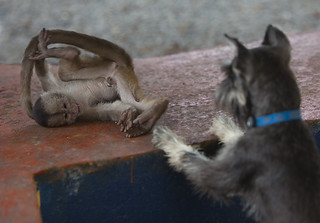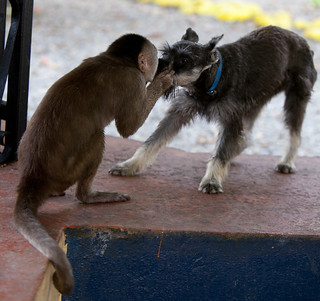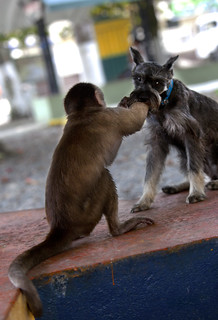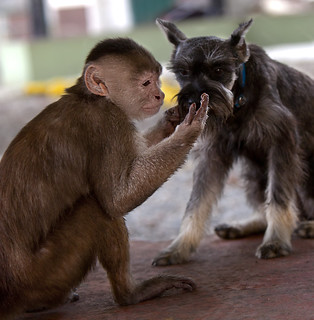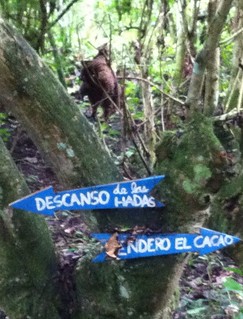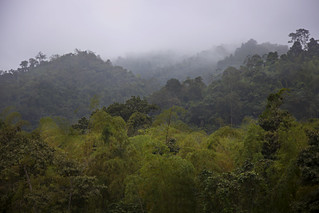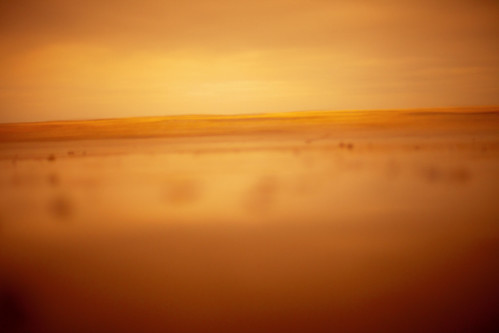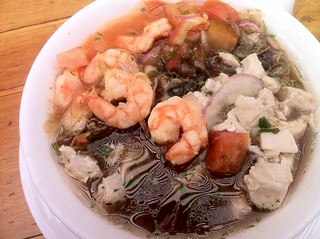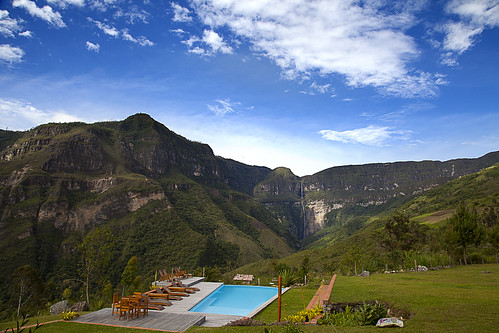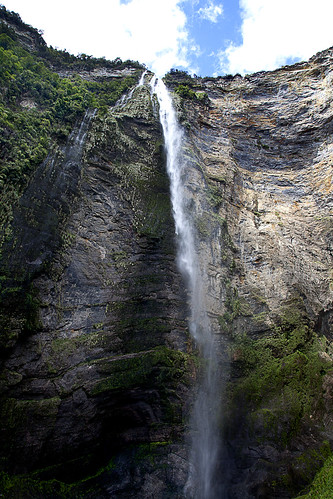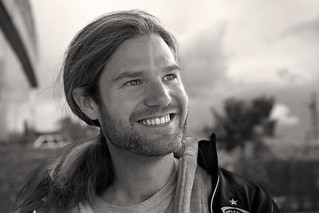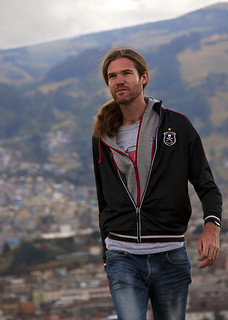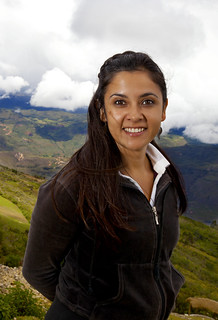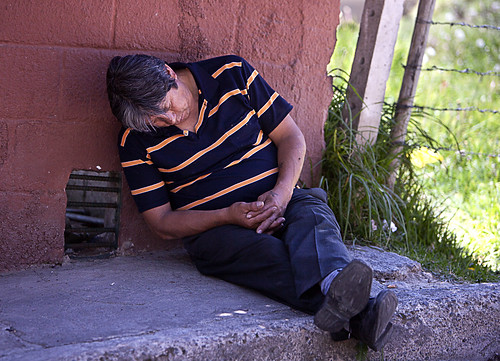I woke up at sunrise and counted my mosquito bites. Four, five, six - that's not too bad. The combination of net, palo santo, repellent cream (which we've christened Stinker Pinker) and a Raid plug-in vaporiser seemed to do the trick.
Breakfast at Casa Andina Hotel in Chachapoyas was papaya juice (which would taste like orange juice, if orange juice was horrible and had no flavour), trusty heuvos fritos, cake and coffee.
We had no clean clothes - or more accurately, we had an entire bag of clean clothes in a launderette 20 miles away, this being the launderette where the owner's dog had shat all over the floor. When the launderette owner clocked my horrified face at the piles of poo he summoned his young daughter to clean it up. She neatly laid sheets of A4 paper over the stinking mounds. There was also a dead rat outside the shop which Lucy nearly stepped on - how she screamed! I've since burnt all my clothes that passed through his doors.
 |
| The plan was simple. To see the Sarcofagi of Karajia |
The plan for the day was simple: to see Sarcofagi of Karajia, a set of mummies placed high in the cliffs by the Chachapoyas people over 500 years ago. On the map it looked simple, the mummies were only 30 miles from our hotel. Reality was going to taste very different from expectation. This is Peru - a benighted land of chaos, a non-existant public transport network, mortal danger at every turn and, as it happens, just about one of the best countries in the whole world.
From the hotel we hiked up the steep chaquinan (footpath) through a chirimoya (deliciously aromatic Peruvian fruit) farm. We reached the road and waited at the local tienda (corner shop) for a collectivo (shared mini-bus taxi) to pass. Lessons over. We waited about an hour and a half.
The small police station opposite was being given a lick of paint. One of the Keystone cops managed to get fresh, white paint all over his trousers. He spent the entire hour and a half rubbing it with dry leaves. In my professional opinion he wanted turpentine, hot water and a clean cloth... but what do I know.
It's only a small police station but it's staffed by at least six officers (or chapas as the Ecuadorians would say). They sit around idly on plastic chairs in the sun and occasionally pull over unlucky motorists to check their papers (if you know what I mean).
Eventually a pick-up truck pulled over to ask for directions. It was a family of day trippers from the other side of Peru. We assured them "their way was our way" and they agreed to let us hop in the back.
Our fellow passenger in the back of the trailer was a young boy whose face had turned an unholy glaucous hue. He wasn't a 'good traveller' we'd been pre-warned and he had been vomiting steadily all the way from Chiclayo (about 200 miles away). The poor lad looked very sorry for himself but Lucy and I had more pressing concerns: i.e - avoiding the slithering sick that snaked like the great, grey, green, greasy Limpopo river about the trailer.
We soon turned off the main road and headed up the rough mountain track to Lamud. A rare signpost revealed it was a journey of 16 kilometres. We braced ourselves for the pain in the rear of this crude truck. The road was steep and rutted and every shock jarred our spines and rattled our bones. It was agony. I was trying to count down the kilometres in my head, promising my body the pain would soon be at an end.
I guessed we had traveled about 10km when our truck suddenly pulled to a halt. "This is where they murder us," I half-joked. But it was a fate worse than death. The tank was running dangerously low on petrol so, with fuel stations few and far between, we had to u-turn and freewheel back down the painful road. 'Should we walk the last six kilometres?' I wondered. But the midday sun was scorching and neither of us were entirely certain of where we were.
We bounced back to the bottom of the hill, waved goodbye to the family who headed off in search of petrol and sat down on the hot road to wait for another lift. Nothing much passed along this sleepy road and it was an hour before another truck let us jump into the trailer. Neither of us relished repeating the journey after the agony of the last trip but if we wanted to see those bloody mummies we were just going to have to soak up the pain and think of England.
Fortunately, this truck was a brand new Toyota Hilux with state-of-the-art suspension. I can almost say I enjoyed the ride, basking like a lizard on a rock under the strength of the sun. The scenery north of Chachapoyas is stunning. Rapid rivers snake and churn through deep valleys and the mountains rise like stately domes, covered in lush trees bearing wild, and exotic fruits.
When we reached the town of Luya we dismounted and shook aches from our battered bones. We found a taxi driver who agreed to take us to the closest village to the mummies (Cruzpata), wait for us, and return us to town. We negotiated a price and hopped in.
The village of Cruzpata is tiny. There are no gift shops, no restaurants, in fact, the only clue that one of the most incredible archaeological sites of northern Peru lay just over the horizon was a battered sign pointing down a rough farm track. It promised mummies were just a kilometre away, although I'd guess it's at least twice that distance.
The remote countryside around Cruzpata is a paradise. Wild flowers grow rich, blooming blue, crimson and a pastel, ecclesiastical purple. In the surrounding fields ploughs are still pulled by a pair of oxen and local boys spray dangerous pesticides from hand pumps without masks.
After a couple of kilometres down the track, the fertile farm land drops away into a steep valley met by sheer cliffs. A narrow footpath hacked into the rock hugs the cliff wall. It winds tightly about the mountainside so at first you don't see the mummies... but then you do and it makes you want to cry.
High in the seemingly unassailable rocks, 200 metres above the base of the gorge, are seven white figures standing 10-feet tall. Their large, expressionless, anthropomorphous faces are striking even from a distance and eerie human skulls have been balanced atop their heads. These are the faces of icons and they have stared out across this abandoned valley with the same unblinking eyes for over 500 years. Nobody is around. There are no tourists, no farmers, no signs of civilisation. It was just myself, Lucy and the Chachapoyan mummies.
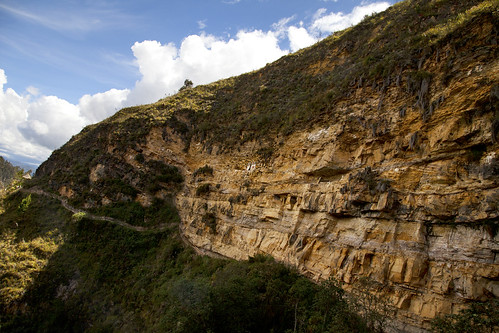 |
| The narrow path carved into the cliff below the mummies |
An eighth mummy had once stood with his comrades but an earthquake in the 1920s shook him from his perch. The damage allowed daring archaeologists to scale the cliffs and investigate. They found a mummy wrapped in funeral cloths and seated on animal skins. About the body were ceramics and other objects of value.
The Sarcofagi of Karajia (or sometimes Carajia) are still a mystery. The certainty of modern technology places them around 1470s - the height of the Incan Empire's ascendancy and just a decade before the Spanish ships landed on the coast of the New World. But modern technology can tell us little about the myths and cosmo-vision of this strange, cloud people from the high-Andes.
Presumably the sarcofagi contained the bodies of revered and respected Chachapoyan leaders - you would have to consider somebody pretty special to go to this much effort and danger with their entombment. But it was only their inaccessibility that spared them from grave robbers. I could not believe such an ancient and incredible site was still standing in the cliff-face, bearing against the elements, the earthquakes and the ravages of human civilisation.
For a spark of a second I wondered if they should be saved before some natural disaster or other befalls them, before they rot away or topple over the cliff-edge like unlucky number eight. But no sooner had the thought occurred to me than I discarded it. Hermetically sealed behind glass, grease-stained from the pressed-noses, and lit by the museum's somber lighting and warning signs of "no flash photography" would have stripped the mummies of all solemnity and dignity - just another exhibit collecting dust.
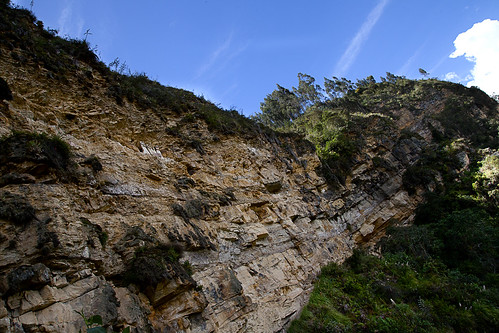 |
| This is where you first see the mummies, 200 metres above the valley floor |
We had promised our taxi driver we would only be 90 minutes. We'd got lost in the mummies and had left just 15 minutes for the return journey. The thought of getting stranded in the remote village of Cruspatra wasn't particularly appealing so we both braced our backs for the uphill trudge. By now the sun was unbearable so I wrapped my scarf around me like Lawrence of Arabia, much to the amusement of the local farmers.
The taxi driver was in no hurry to leave so I felt a bit foolish (and English) arriving red-faced, breathless and bang on 15:30 as promised.
On the way back to town we picked up an old Indian woman who looked about 98-years-old. Ten minutes later we stopped for another two Indian women who were both carrying enormous bags of corn. So then there were six of us in a knackered, old taxi. The Indians were sat on each other's laps and asked Lucy lots of questions. It was about then our taxi broke down for the first time, apparently some sort of electrical problem. The driver was no stranger to the fault - I suspect he probably has to fix it several times a day. Minutes later the engine cut out again and required another tinkering before we could continue.
The Indians with the corn got out at a farming village near Luya. As they clambered out of the taxi their enormous bag split and dried corn covered the rear seats and road. Lucy spotted the cheeky, 98-year-old Indian sneaking a handful into her pocket. I helped the women pick it up, grain-by-bloody-grain. Hoovering the corn off the road was at least 15 per cent grit - I wouldn't fancy crunching through their tostado later.
Back in town we had some time before the collectivo left for Chachapoyas so Lucy struck upon the idea of finding a local chicheria to buy some fresh chicha - the corn-brewed booze of the Incas. Chicha is shockingly cheap, we paid two soles for two litres - that's about 25 pence. A bargain perhaps, but it did come in a filthy Sprite bottle and had bits floating in it. Later that night we took our filthy, plastic bottle of chicha to the elegant riverside restaurant in our hotel and poured it out like a bottle of vintage Margaux.
It took a long time for the collectivo to pull out of Luya because two female passengers were having a noisy argument about paying an electricity bill. The run down the mountain was terrifying in the rattly, old minibus but the driver didn't seem too concerned about the gravelly road, the hairpin bends and the 500ft sheer drops. At one point we overtook a police car on a blind bend, wheels spinning for traction and our bus under-steering towards the valley below.
Safely back at the chirimoya farm I stopped for a couple of calming, cold beers from the tienda. There was some confusion and I ended up paying ten soles too little and walking off. Lucy was chatting to the policemen when I returned with the shop owner in hot pursuit. The police only laughed as I swigged from an open alcohol bottle in front of them. Another one of Peru's less enforced laws, I learned (luckily).
We stopped on the walk back down the steep valley path to the hotel under the shade of a chirimoya tree and drank the cold beer as the sun set. It was the first time I'd had to reflect during a hectic day. The journey to see the mummies had been challenging and at moments it almost defeated us. We were sunburned, dehydrated, dusty and sore but the Sarcophagus de Karajia are like nothing I've ever seen before and worth every ounce of pain.
